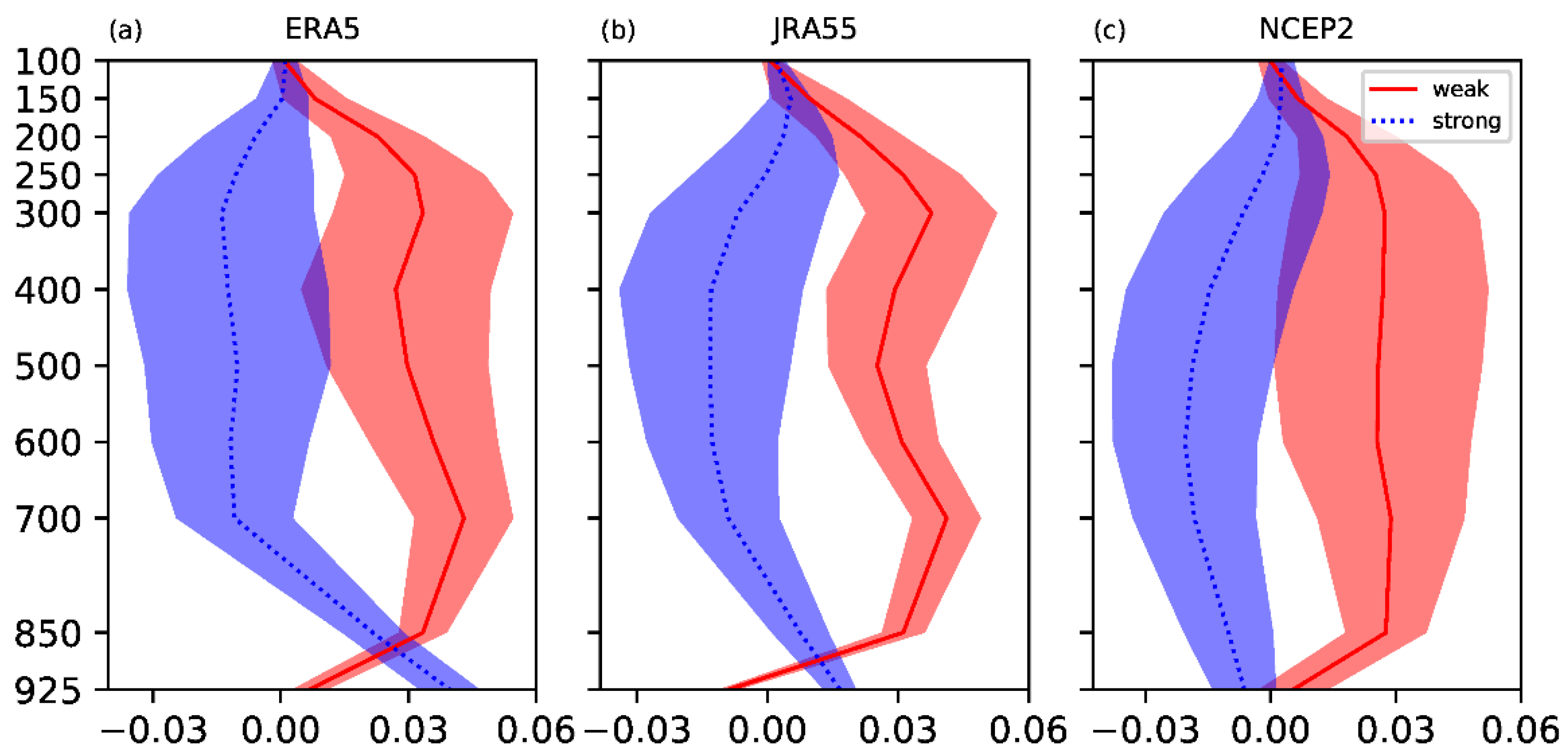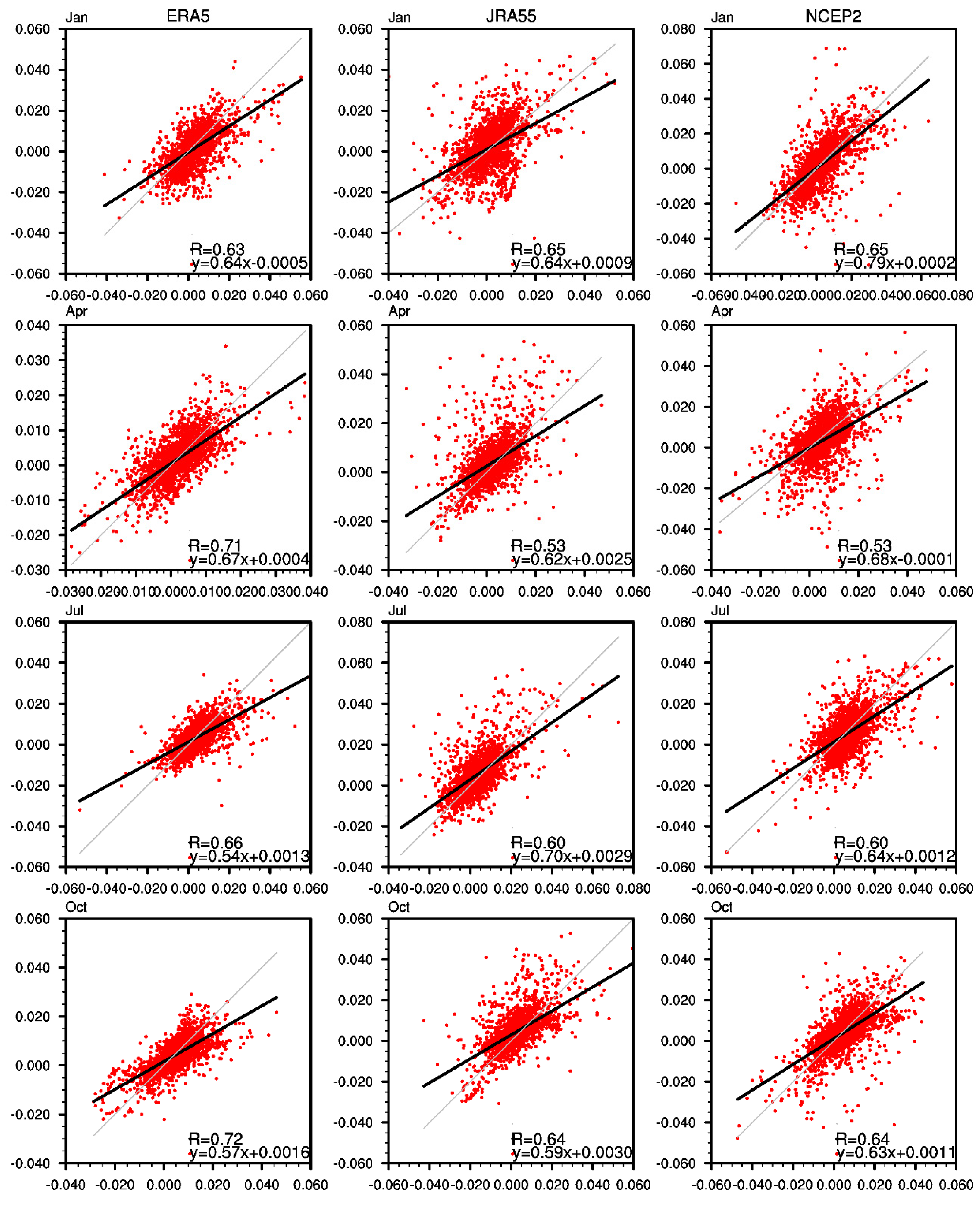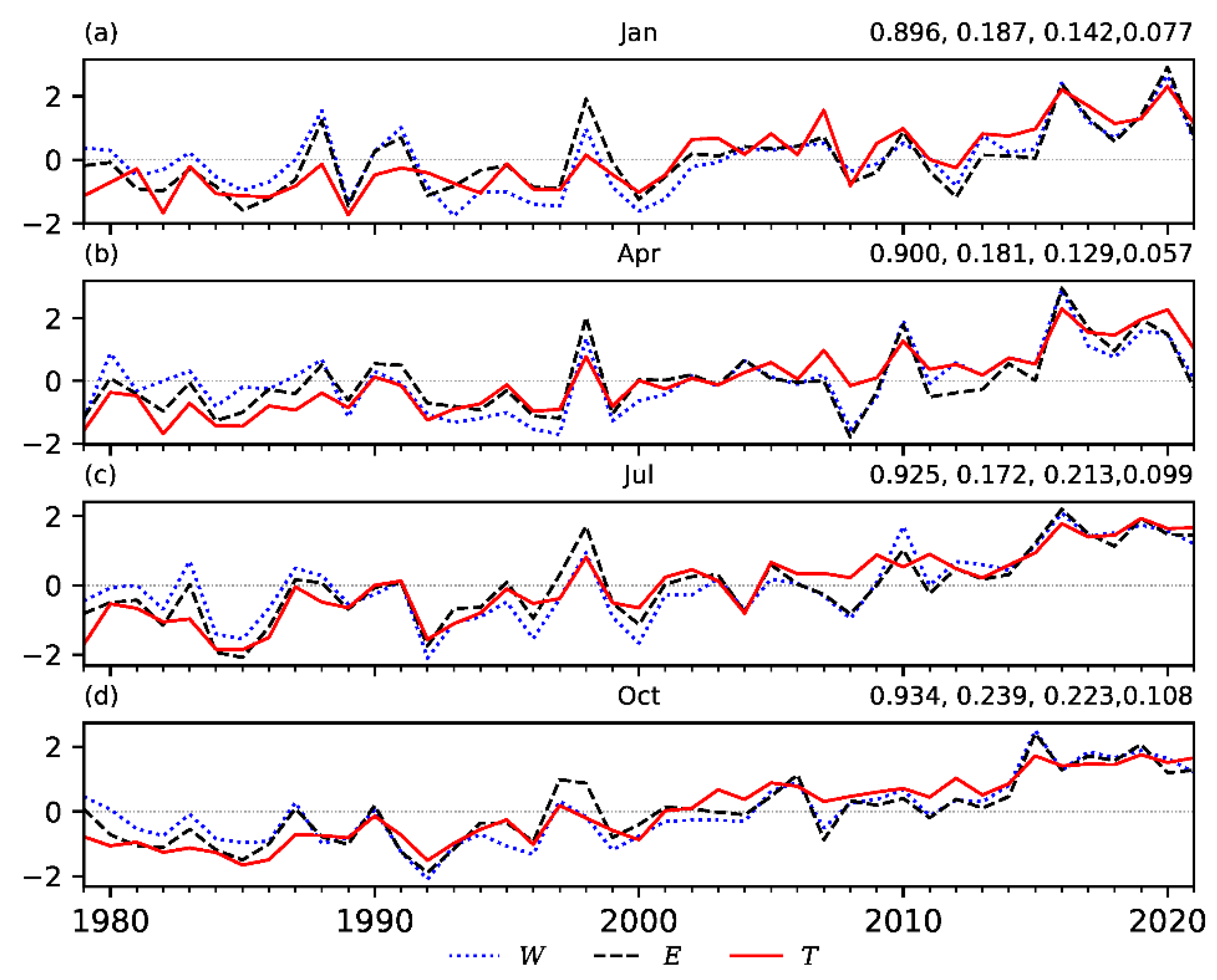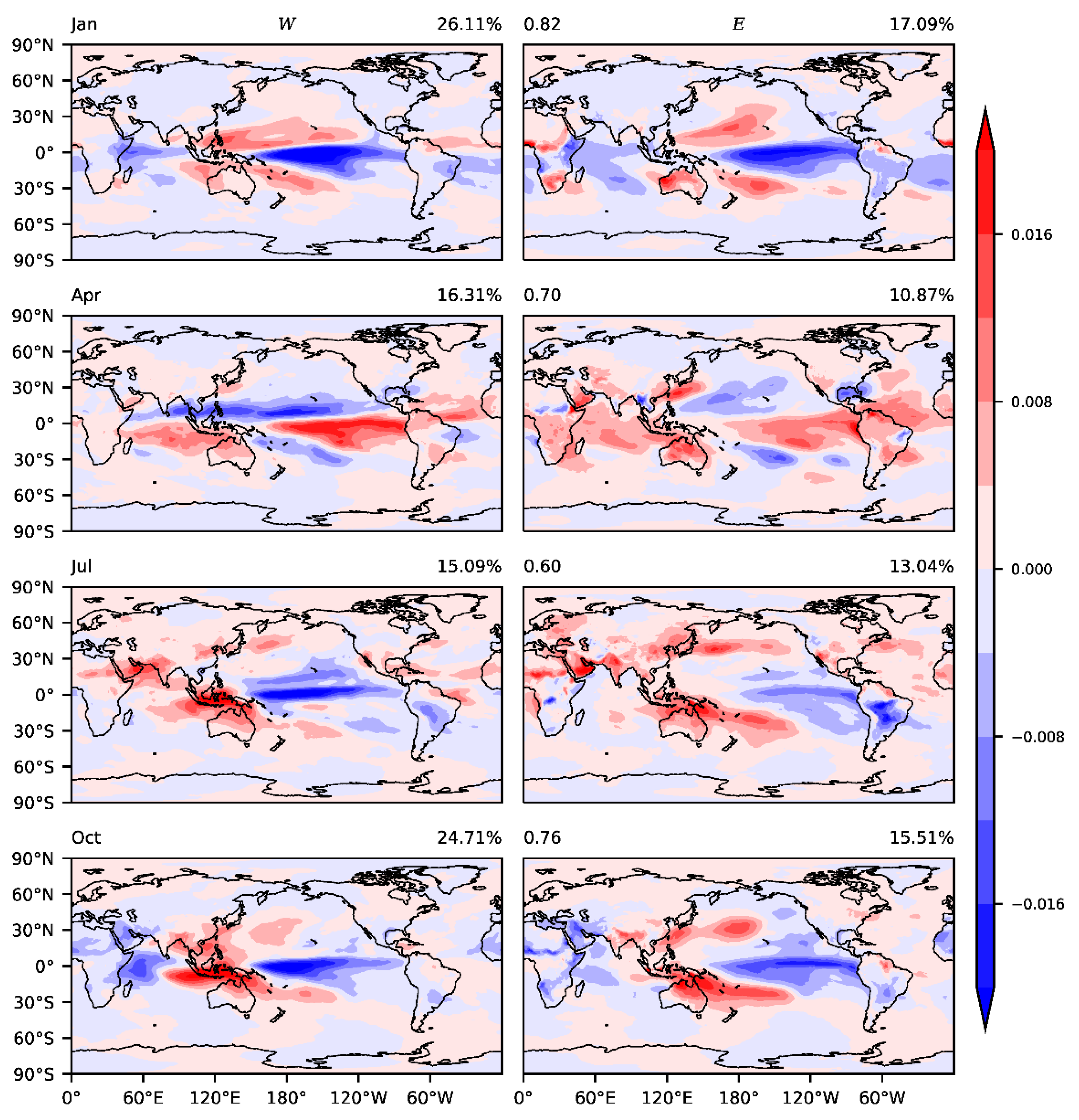The Consistent Variations of Precipitable Water and Surface Water Vapor Pressure at Interannual and Long-Term Scales: An Examination Using Reanalysis
Abstract
1. Introduction
2. Data and Method
2.1. Data
2.2. Method
2.2.1. Mann–Kendall Test and Sen’s Slope Estimator
2.2.2. Empirical Orthogonal Function (EOF) Analysis
2.2.3. The Theoretical Linkage between PW and SVP
3. Results
3.1. The Consistency of Interannual Variations
3.2. Consistency of Long-Term Trends
3.3. The Consistency of the First Leading EOF Modes
4. Summary and Discussion
Supplementary Materials
Author Contributions
Funding
Institutional Review Board Statement
Informed Consent Statement
Data Availability Statement
Acknowledgments
Conflicts of Interest
References
- Stewart, R.E.; Crawford, R.W.; Leighton, H.G.; Marsh, P.; Strong, G.S.; Moore, G.W.K.; Ritchie, H.; Rouse, W.R.; Soulis, E.D.; Kochtubajda, B. The Mackenzie GEWEX Study: The Water and Energy Cycles of a Major North American River Basin. Bull. Am. Meteorol. Soc. 1998, 79, 2665–2683. [Google Scholar] [CrossRef]
- Semmler, T.; Jacob, D.; Schlünzen, K.H.; Podzun, R. The Water and Energy Budget of the Arctic Atmosphere. J. Clim. 2005, 18, 2515–2530. [Google Scholar] [CrossRef][Green Version]
- Trenberth, K.E.; Fasullo, J. Regional Energy and Water Cycles: Transports from Ocean to Land. J. Clim. 2013, 26, 7837–7851. [Google Scholar] [CrossRef]
- Mathew, S.S.; Kumar, K.K. On the role of precipitation latent heating in modulating the strength and width of the Hadley circulation. Arch. Meteorol. Geophys. Bioclimatol. Ser. B 2018, 136, 661–673. [Google Scholar] [CrossRef]
- Hao, J.; Lu, E. The quantitative comparison of contributions from vapour and temperature to midsummer precipitation in China under the influence of spring heat source over Tibet Plateau. Int. J. Clim. 2021, 42, 1754–1766. [Google Scholar] [CrossRef]
- Zhou, T.-J.; Yu, R.-C. Atmospheric water vapor transport associated with typical anomalous summer rainfall patterns in China. J. Geophys. Res. Atmos. 2005, 110. [Google Scholar] [CrossRef]
- Rädel, G.; Shine, K.P.; Ptashnik, I.V. Global radiative and climate effect of the water vapour continuum at visible and near-infrared wavelengths. Q. J. R. Meteorol. Soc. 2014, 141, 727–738. [Google Scholar] [CrossRef]
- Wang, Y.; Zhang, Y.; Fu, Y.; Li, R.; Yang, Y.-J. A climatological comparison of column-integrated water vapor for the third-generation reanalysis datasets. Sci. China Earth Sci. 2015, 59, 296–306. [Google Scholar] [CrossRef]
- Cady-Pereira, K.; Shephard, M.; Turner, D.; Mlawer, E.; Clough, S.; Wagner, T. Improved daytime column-integrated precipitable WV from Vaisala radiosonde humidity sensors. J. Atmos. Ocean. Technol. 2008, 25, 873–883. [Google Scholar] [CrossRef]
- Durre, I.; Williams, C.N.; Yin, X.; Vose, R.S. Radiosonde-based trends in precipitable water over the Northern Hemisphere: An update. J. Geophys. Res. Earth Surf. 2009, 114. [Google Scholar] [CrossRef]
- Wang, J.X.L.; Gaffen, D.J. Late-Twentieth-Century Climatology and Trends of Surface Humidity and Temperature in China. J. Clim. 2001, 14, 2833–2845. [Google Scholar] [CrossRef]
- Dai, A. Recent Climatology, Variability, and Trends in Global Surface Humidity. J. Clim. 2006, 19, 3589–3606. [Google Scholar] [CrossRef]
- Willett, K.M.; Jones, P.; Gillett, N.P.; Thorne, P. Recent Changes in Surface Humidity: Development of the HadCRUH Dataset. J. Clim. 2008, 21, 5364–5383. [Google Scholar] [CrossRef]
- Isaac, V.; Van Wijngaarden, W. Surface WV pressure and temperature trends in North America during 1948–2010. J. Clim. 2012, 25, 3599–3609. [Google Scholar] [CrossRef]
- Wallace, J.M.; Hobbs, P.V. Atmospheric Science: An Introductory Survey; Elsevier: Amsterdam, The Netherlands, 2006; 483p. [Google Scholar]
- Lu, E.; Zeng, X. Understanding different precipitation seasonality regimes from WV and temperature fields: Case studies. Geophys. Res. Lett. 2005, 32, 1154–1158. [Google Scholar] [CrossRef]
- Lu, E. Understanding the effects of atmospheric circulation in the relationships between water vapor and temperature through theoretical analyses. Geophys. Res. Lett. 2007, 34. [Google Scholar] [CrossRef]
- Reber, E.E.; Swope, J.R. On the Correlation of the Total Precipitable Water in a Vertical Column and Absolute Humidity at the Surface. J. Appl. Meteorol. 1972, 11, 1322–1325. [Google Scholar] [CrossRef]
- Viswanadham, Y. The Relationship between Total Precipitable Water and Surface Dew Point. J. Appl. Meteorol. 1981, 20, 3–8. [Google Scholar] [CrossRef]
- Liu, W.T. Statistical Relation between Monthly Mean Precipitable Water and Surface-Level Humidity over Global Oceans. Mon. Weather Rev. 1986, 114, 1591–1602. [Google Scholar] [CrossRef]
- Hsu, S.A.; Blanchard, B.W. The relationship between total precipitable water and surface-level humidity over the sea surface: A further evaluation. J. Geophys. Res. Earth Surf. 1989, 94, 14539–14545. [Google Scholar] [CrossRef]
- Dostalek, J.F.; Schmit, T.J. Total Precipitable Water Measurements from GOES Sounder Derived Product Imagery. Weather Forecast. 2001, 16, 573–587. [Google Scholar] [CrossRef]
- Deeter, M.N. A new satellite retrieval method for precipitable water vapor over land and ocean. Geophys. Res. Lett. 2007, 34. [Google Scholar] [CrossRef]
- Radhakrishna, B.; Fabry, F.; Braun, J.J.; Van Hove, T. Precipitable Water from GPS over the Continental United States: Diurnal Cycle, Intercomparisons with NARR, and Link with Convective Initiation. J. Clim. 2015, 28, 2584–2599. [Google Scholar] [CrossRef]
- Torri, G.; Adams, D.K.; Wang, H.; Kuang, Z. On the diurnal cycle of GPS-derived precipitable WV over Sumatra. J. Atmos. Sci. 2019, 76, 3529–3552. [Google Scholar] [CrossRef]
- Zveryaev, I.I.; Chu, P.-S. Recent climate changes in precipitable water in the global tropics as revealed in National Centers for Environmental Prediction/National Center for Atmospheric Research reanalysis. J. Geophys. Res. Atmos. 2003, 108, ACL6.1–ACL6.10. [Google Scholar] [CrossRef]
- Ssenyunzi, R.C.; Oruru, B.; D’ujanga, F.M.; Realini, E.; Barindelli, S.; Tagliaferro, G.; von Engeln, A.; van de Giesen, N. Performance of ERA5 data in retrieving Precipitable Water Vapour over East African tropical region. Adv. Space Res. 2020, 65, 1877–1893. [Google Scholar] [CrossRef]
- Maghrabi, A.; Al Dajani, H. Estimation of precipitable water vapour using vapour pressure and air temperature in an arid region in central Saudi Arabia. J. Assoc. Arab Univ. Basic Appl. Sci. 2013, 14, 45–49. [Google Scholar] [CrossRef][Green Version]
- Chadwick, R.; Good, P.; Willett, K. A Simple Moisture Advection Model of Specific Humidity Change over Land in Response to SST Warming. J. Clim. 2016, 29, 7613–7632. [Google Scholar] [CrossRef]
- Gaffen, D.J.; Elliott, W.P.; Robock, A. Relationships between tropospheric WV and surface temperature as observed by radiosondes. Geophys. Res. Lett. 1992, 19, 1839–1842. [Google Scholar] [CrossRef]
- Sun, D.-Z.; Held, I.M. A comparison of modeled and observed relationships between interannual variations of WV and temperature. J. Clim. 1996, 9, 665–675. [Google Scholar] [CrossRef]
- Bauer, M.; Del Genio, A.D.; Lanzante, J.R. Observed and Simulated Temperature–Humidity Relationships: Sensitivity to Sampling and Analysis. J. Clim. 2002, 15, 203–215. [Google Scholar] [CrossRef][Green Version]
- Mears, C.A.; Santer, B.D.; Wentz, F.J.; Taylor, K.E.; Wehner, M.F. Relationship between temperature and precipitable water changes over tropical oceans. Geophys. Res. Lett. 2007, 34. [Google Scholar] [CrossRef]
- Laine, A.; Nakamura, H.; Nishii, K.; Miyasaka, T. A diagnostic study of future evaporation changes projected in CMIP5 climate models. Clim. Dyn. 2014, 42, 2745–2761. [Google Scholar] [CrossRef]
- Trenberth, K.E.; Fasullo, J.; Smith, L. Trends and variability in column-integrated atmospheric WV. Clim. Dyn. 2005, 24, 741–758. [Google Scholar] [CrossRef]
- Chung, E.-S.; Soden, B.; Sohn, B.J.; Shi, L. Upper-tropospheric moistening in response to anthropogenic warming. Proc. Natl. Acad. Sci. USA 2014, 111, 11636–11641. [Google Scholar] [CrossRef]
- Zhang, Y.; Xu, J.; Yang, N.; Lan, P. Variability and Trends in Global Precipitable Water Vapor Retrieved from COSMIC Radio Occultation and Radiosonde Observations. Atmosphere 2018, 9, 174. [Google Scholar] [CrossRef]
- Schröder, M.; Lockhoff, M.; Shi, L.; August, T.; Bennartz, R.; Brogniez, H.; Calbet, X.; Fell, F.; Forsythe, J.; Gambacorta, A.; et al. The GEWEX Water Vapor Assessment: Overview and Introduction to Results and Recommendations. Remote Sens. 2019, 11, 251. [Google Scholar] [CrossRef]
- Hao, J.; Lu, E. Variation of Relative Humidity as Seen through Linking Water Vapor to Air Temperature: An Assessment of Interannual Variations in the Near-Surface Atmosphere. Atmosphere 2022, 13, 1171. [Google Scholar] [CrossRef]
- Shi, L.; Schreck, C.; Schröder, M. Assessing the Pattern Differences between Satellite-Observed Upper Tropospheric Humidity and Total Column Water Vapor during Major El Niño Events. Remote Sens. 2018, 10, 1188. [Google Scholar] [CrossRef]
- Smith, T.M.; Arkin, P.A. Improved Historical Analysis of Oceanic Total Precipitable Water. J. Clim. 2015, 28, 3099–3121. [Google Scholar] [CrossRef]
- Wang, J.; Dai, A.; Mears, C. Global Water Vapor Trend from 1988 to 2011 and Its Diurnal Asymmetry Based on GPS, Radiosonde, and Microwave Satellite Measurements. J. Clim. 2016, 29, 5205–5222. [Google Scholar] [CrossRef]
- Hersbach, H.; Bell, B.; Berrisford, P.; Hirahara, S.; Horanyi, A.; Muñoz-Sabater, J.; Nicolas, J.; Peubey, C.; Radu, R.; Schepers, D.; et al. The ERA5 global reanalysis. Q. J. R. Meteorol. Soc. 2020, 146, 1999–2049. [Google Scholar] [CrossRef]
- Kanamitsu, M.; Ebisuzaki, W.; Woollen, J.; Yang, S.-K.; Hnilo, J.J.; Fiorino, M.; Potter, G.L. NCEP–DOE AMIP-II Reanalysis (R-2). Bull. Am. Meteorol. Soc. 2002, 83, 1631–1644. [Google Scholar] [CrossRef]
- Kobayashi, S.; Ota, Y.; Harada, Y.; Ebita, A.; Moriya, M.; Onoda, H.; Onogi, K.; Kamahori, H.; Kobayashi, C.; Endo, H.; et al. The JRA-55 Reanalysis: General Specifications and Basic Characteristics. J. Meteorol. Soc. Jpn. Ser. II 2015, 93, 5–48. [Google Scholar] [CrossRef]
- Alduchov, O.A.; Eskridge, R.E. Improved Magnus Form Approximation of Saturation Vapor Pressure. J. Appl. Meteorol. 1996, 35, 601–609. [Google Scholar] [CrossRef]
- Duhan, D.; Pandey, A. Statistical analysis of long term spatial and temporal trends of precipitation during 1901–2002 at Madhya Pradesh, India. Atmos. Res. 2013, 122, 136–149. [Google Scholar] [CrossRef]
- Jain, S.K.; Kumar, V. Trend analysis of rainfall and temperature data for India. Curr. Sci. 2012, 102, 37–49. [Google Scholar]
- Mann, H.B. Nonparametric tests against trend. Econometrica 1945, 13, 245–259. [Google Scholar] [CrossRef]
- Kendall, M.G. Rank Correlation Methods; Charles Grifin: London, UK, 1970; 202p. [Google Scholar]
- Mondal, A.; Kundu, S.; Mukhopadhyay, A. Rainfall trend analysis by Mann-Kendall test: A case study of north-eastern part of Cuttack district, Orissa. Int. J. Geol. Earth Environ. Sci. 2012, 2, 70–78. [Google Scholar]
- Hamed, K.H.; Rao, A.R. A modified Mann-Kendall trend test for autocorrelated data. J. Hydrol. 1998, 204, 182–196. [Google Scholar] [CrossRef]
- Sen, P.K. Estimates of the regression coefficient based on Kendall’s tau. J. Am. Stat. Assoc. 1968, 63, 1379–1389. [Google Scholar] [CrossRef]
- Pal, A.B.; Khare, D.; Mishra, P.K.; Singh, L. Trend analysis of rainfall, temperature and runoff data: A case study of Rangoon watershed in Nepal. Int. J. Stud. Res. Technol. Manag. 2017, 5, 21–38. [Google Scholar] [CrossRef]
- Schwing, F.; Murphree, T.; Green, P. The Northern Oscillation Index (NOI): A new climate index for the northeast Pacific. Prog. Oceanogr. 2002, 53, 115–139. [Google Scholar] [CrossRef]
- Overland, J.E.; Preisendorfer, R.W. A Significance Test for Principal Components Applied to a Cyclone Climatology. Mon. Weather Rev. 1982, 110, 699–706. [Google Scholar] [CrossRef]
- Peixoto, J.P.; Oort, A.H. Physics of Climate; American Institute of Physics: New York, NY, USA, 1992; 520p. [Google Scholar]










| Datasets | Single Level Variables | Pressure Level Variables | |
|---|---|---|---|
| ERA5 | 2 m temperature (saturated SVP) 2 m dewpoint temperature (SVP) precipitable water | vertical velocity temperature (saturated SVP) | specific humidity |
| JRA55 | |||
| NCEP2 | relative humidity (specific humidity) | ||
Publisher’s Note: MDPI stays neutral with regard to jurisdictional claims in published maps and institutional affiliations. |
© 2022 by the authors. Licensee MDPI, Basel, Switzerland. This article is an open access article distributed under the terms and conditions of the Creative Commons Attribution (CC BY) license (https://creativecommons.org/licenses/by/4.0/).
Share and Cite
Hao, J.; Lu, E. The Consistent Variations of Precipitable Water and Surface Water Vapor Pressure at Interannual and Long-Term Scales: An Examination Using Reanalysis. Atmosphere 2022, 13, 1350. https://doi.org/10.3390/atmos13091350
Hao J, Lu E. The Consistent Variations of Precipitable Water and Surface Water Vapor Pressure at Interannual and Long-Term Scales: An Examination Using Reanalysis. Atmosphere. 2022; 13(9):1350. https://doi.org/10.3390/atmos13091350
Chicago/Turabian StyleHao, Jiawei, and Er Lu. 2022. "The Consistent Variations of Precipitable Water and Surface Water Vapor Pressure at Interannual and Long-Term Scales: An Examination Using Reanalysis" Atmosphere 13, no. 9: 1350. https://doi.org/10.3390/atmos13091350
APA StyleHao, J., & Lu, E. (2022). The Consistent Variations of Precipitable Water and Surface Water Vapor Pressure at Interannual and Long-Term Scales: An Examination Using Reanalysis. Atmosphere, 13(9), 1350. https://doi.org/10.3390/atmos13091350







